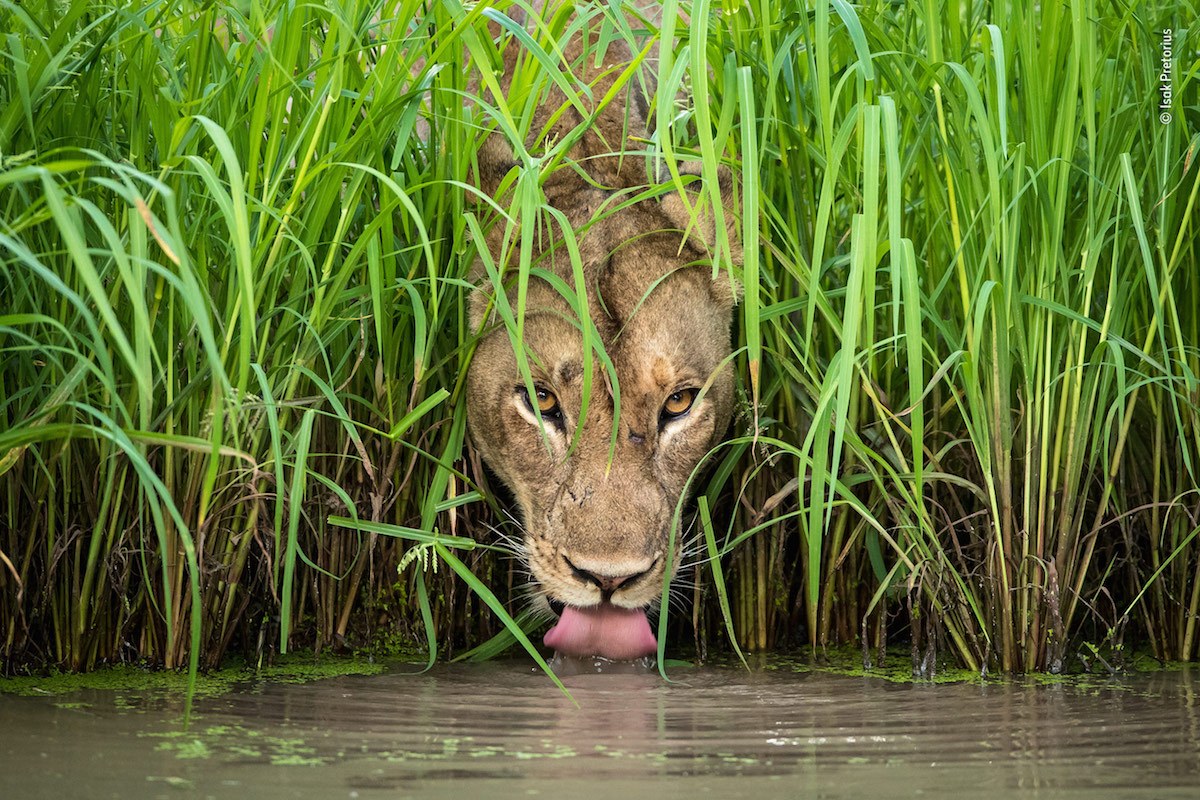
“Cool cat” by Isak Pretorius, South Africa / Wildlife Photographer of the Year.
A lioness drinks from a waterhole in Zambia’s South Luangwa National Park. Sheis one of the Mfuwe Lodge pride –two males, five females and five cubs. Isak had been keeping watch on them while they slept off a feast from a buffalokill the night before. Lions kill more than 95 per cent of their prey at night and may spend 18–20 hours resting. When this female got up and walked off, Isak anticipated that she might be going for a drink, and so he headed for the nearest waterhole. Though lions can get most of the moisture they need from their prey and even from plants, they drink regularly when water is available. Isak positioned his vehicle on the opposite side of the waterhole, close to the edge, steadying his long lens in the low light on a bean bag. Sure enough, the lioness appeared through the tall, rainy-season grass and hunched down to drink, occasionally looking up or sideways. With perfect timing, Isak caught her gaze and her tongue, lapping the water, framed by the wall of lush green.
Now in its 54th year, Natural History Museum has just revealed a selection of spectacular, highly commended photos from the 2018 Wildlife Photographer of the Year contest. More than 45,000 entries were submitted from amateur and professional photographers from across 95 countries. The selected images give a breathtaking view into the mysterious natural world, the lives of wild animals, and the impact that humanity has had on our planet.
From a lioness cooling off at a watering hole to a pair of Eurasian lynx play-fighting in a snow-covered Bavarian forest, many of the images reveal beautiful, intimate moments in the wild. Other images document the harsh reality of the natural world, such as Nicholas Dyer’s grisly image of pair of African wild dogs playing a game of tag with the head of a baboon. And Greg Lecoeur’s image, titled Life among litter, captures a Sargassumfish swimming among plastic waste—a sad reality for many creatures of the sea today.
“We were captivated by the outstanding quality of the images entered into this year’s competition, which spoke volumes to us about the passion for nature shared by talented photographers across the world,” said Ian Owens, Director of Science at the Natural History Museum and member of the judging panel. “I look forward to seeing the winning selection on beautiful lightbox displays in the exhibition. I’m sure the images will surprise and inspire our visitors, and raise awareness for threatened species and ecosystems.” One hundred of the best entries will be shown in the Natural History Museum from October 19, 2018 through Summer 2019.
You can book tickets for the exhibition on the Natural History Museum website. And if you’re a budding wildlife photographer, you can enter the 2019 Wildlife Photographer of the Year competition from October 22 to December 13, 2018. Scroll down to check out this year’s highly commended images, as well as the stories behind them.
Natural History Museum has just revealed a selection of highly commended photos from the 2018 Wildlife Photographer of the Year contest.
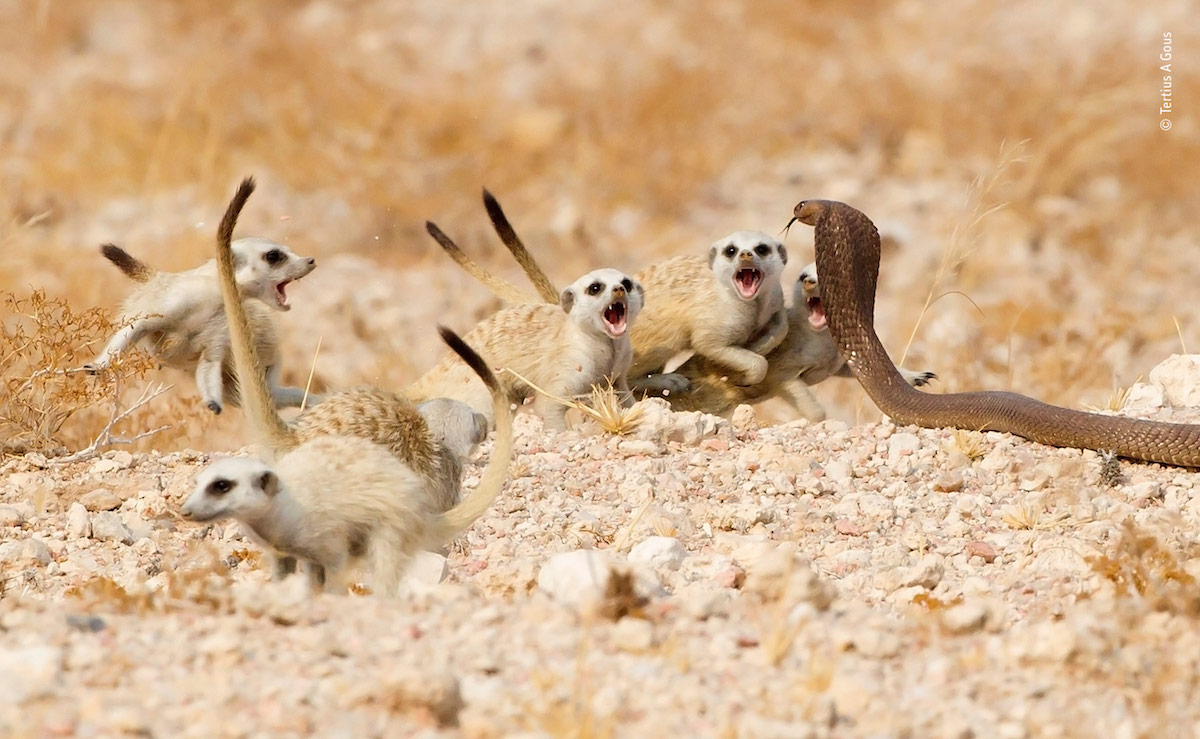
“The meerkat mob” by Tertius A Gous, South Africa / Wildlife Photographer of the Year.
When an Anchieta’s cobra reared its head and moved towards two meerkat pups near their warren on Namibia’s Brandberg Mountain, the rest of the pack–foraging nearby –reacted almost instantly. Rushing back, the20-strong group split into two: one group grabbed the pups and huddled a safe distance away, the other took on the snake. Fluffing up their coats, tails raised, the mob edged forwards, growling. When the snake lunged, they sprang back. This was repeated over and over for about 10 minutes. Tertius had a ringside seat from his vehicle and relished the chance to capture such intense interaction between the meerkat pack and the little known Anchieta’s cobra. Focusing on the snake’s classic profile and flicking tongue, he also caught the expressions of fear and aggression among the meerkats, some facing their attacker and one fleeing. Finally, the cobra gave up and disappeared down a burrow into the warren. Themeerkats reunited and scurried away, most probably to an alternative –snake-free –warren in their territory.
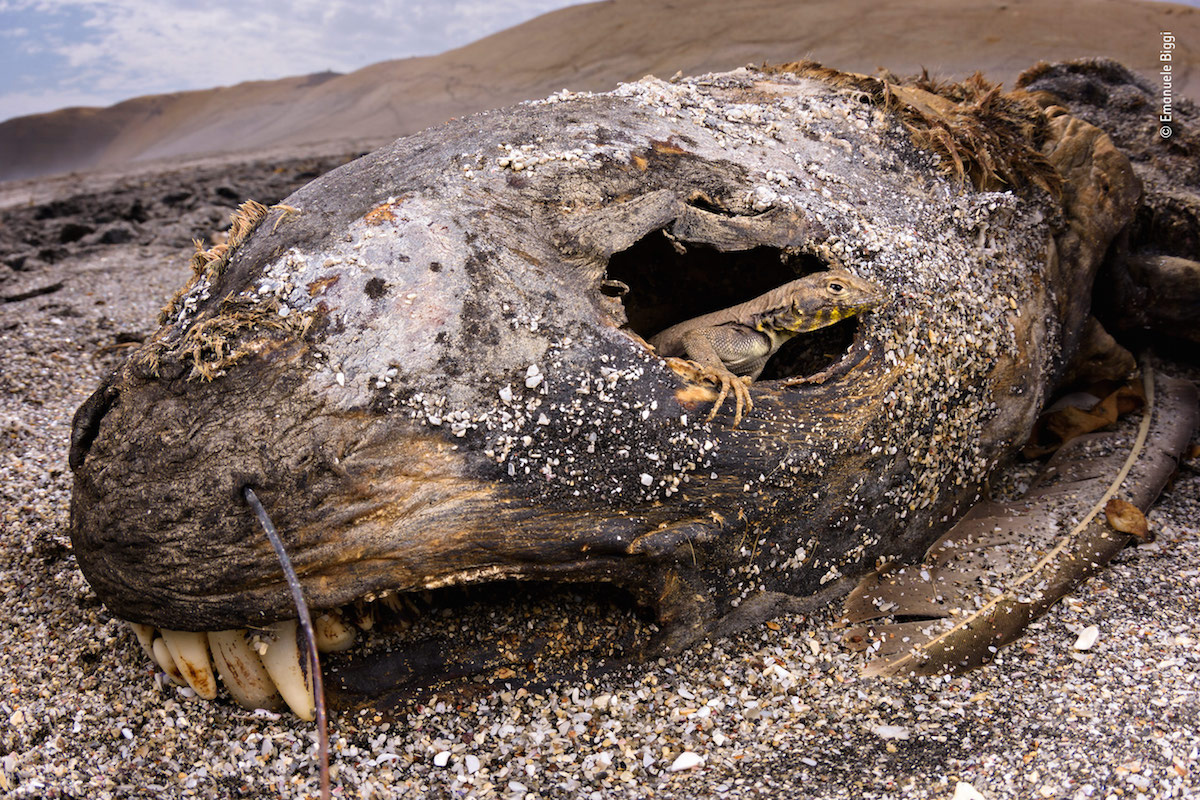
“Eye to eye” by Emanuele Biggi, Italy / Wildlife Photographer of the Year.
The stench was unbearable as Emanuele searched the carcasses for life. Fed by the sea, the desert coast of Peru’s ParacasNational Reserve teems with life. Acolony of South American sea lions supplies the corpses–the result of illness, injuries (some from conflict with fisheries) or occasional die-offs triggered by ElNiño events (when warming of the sea reduces prey availability). The decaying flesh sustains insects and crustaceans, in turn drawing larger predators. Many of the carcasses were flat or too close to the sea, but eventually Emanuele found his frame. A young male Peru Pacific iguana (distinctive black chevronson its throat) had joined the feast within, sheltered from the harsh sun and wind. Lying on the beach, choked by the vile smell until the iguana peeped through the eye socket, Emanuele encapsulated the dependence of terrestrial life on the ocean.

“Kitten combat” by Julius Kramer, Germany / Wildlife Photographer of the Year.
It had been more than a year since Julius set up his camera trap in Germany’s Upper Bavarian Forest, and he had got just two records of Eurasian lynx. He was on the brink of giving up when a biologist colleague insisted that this was ‘such a typical spot for lynx’. Like many solitary cats, the males have expansive home ranges, within which one or more females live. Most active at dawn and dusk, they are powerfully built, with slightly longer hind limbs for pouncing on prey. They hunt mainly herbivores, such as deer, which brings them into conflict with hunters. Julius went on to weather problems including failed batteries, humidity, deep snow and spider webs before his luck changed dramatically. Two six-month-old kittens turned up to play. Honing their hunting skills with joyful exuberance, they rewarded Julius with pictures and the hope that the population might be growing.
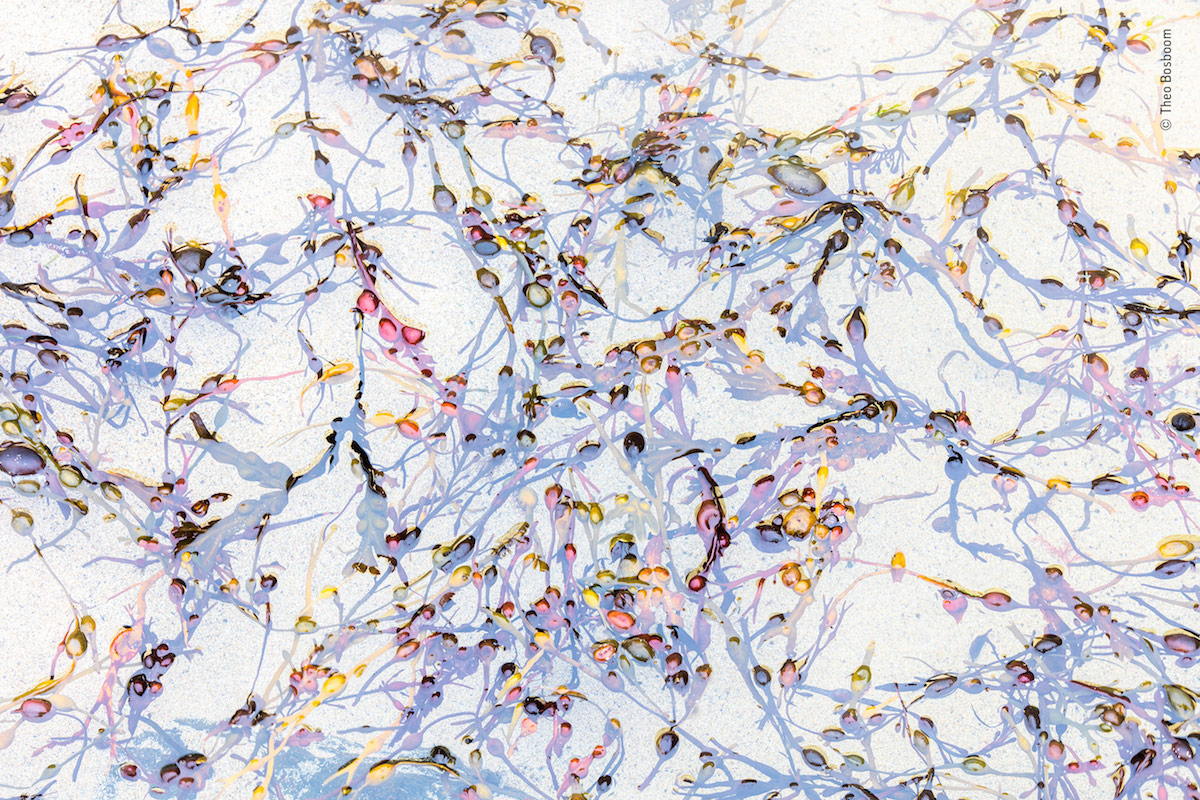
“Simple beauty” by Theo Bosboom, The Netherlands / Wildlife Photographer of the Year.
In a shallow tidal pool, a colorful cluster of detached fronds of egg wrack and bladder wrack form an abstract pattern against white sand. They have been washed off the rocks surrounding Mangersta Sands, on the Isle of Lewis in Scotland’s Outer Hebrides. The air-filled bladders of these marine algae keep their fronds floating and exposed to light so they can photosynthesize. Where they are very exposed to wave action, the seaweed may have no bladders, reducing the risk of being swept away if their holdfasts are ripped from the rocks. Using a polarizing filter to avoid reflections and to reveal details beneath the surface, Theo experimented with focal lengths–while waiting for the wind to stop causing ripples and moving the seaweed. He finally settled on this composition, to reveal what he loves: “The simple beauty of structures and patterns created by nature itself.”
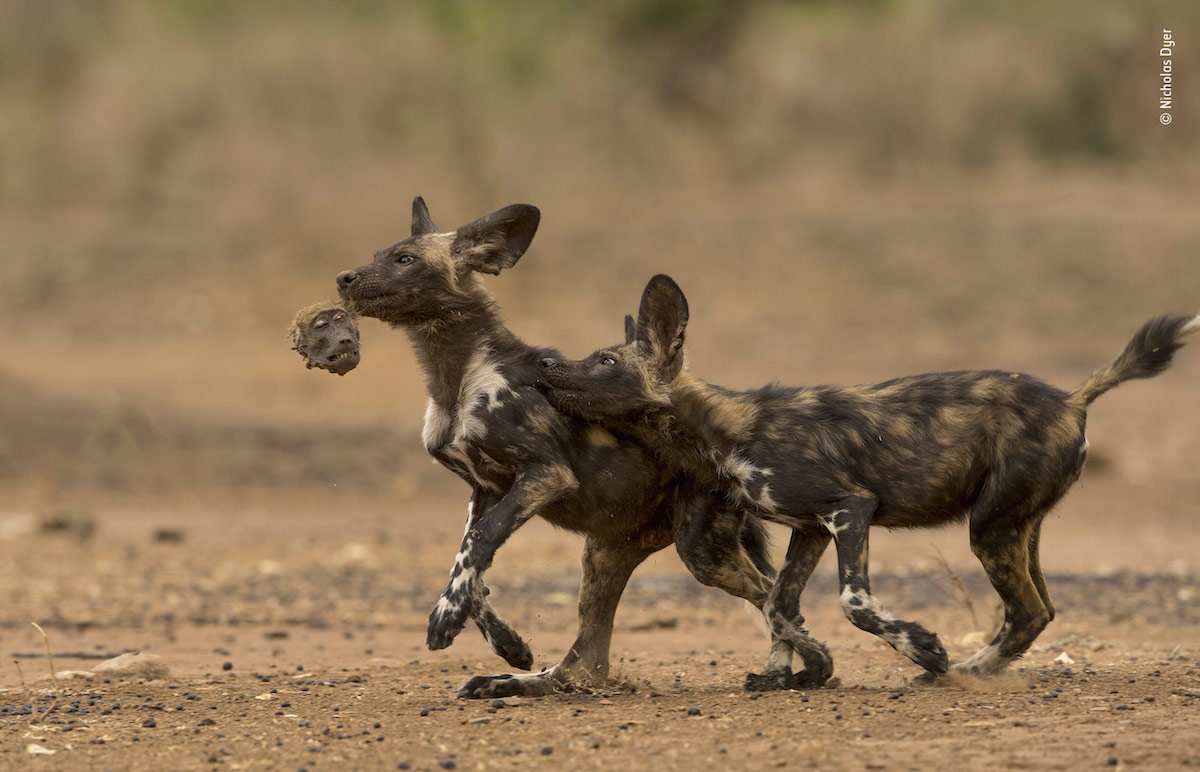
“Ahead in the game” by Nicholas Dyer, UK / Wildlife Photographer of the Year.
A pair of African wild dog pups play a macabre game of tag with the head of a chacma baboon –the remains of their breakfast. The endangered African wild dog (aka the painted hunting dog) is best known for hunting antelopes, such as impalas and kudus. But over the past five years, in Mana Pools National Park, northern Zimbabwe, Nick has witnessed three different packs regularly killing and eating baboons –highly unusual, not least because baboons are capable of inflicting severe wounds. The hunting technique has been perfected by Blacktip, mother of the pups and the alpha female of the Nyakasanga pack. That morning, Nick had tracked a pack on foot for 3 kilometers (nearly 2 miles), taking in two failed impala hunts before the dogs finally seized a baboon. It wasn’t enough to feed the whole pack, but it satisfied nine pups. They stopped short of the baboon’s skull, and then the fun began. Nick, lying nearby, watched more than half an hour of chasing, tackling and tugs-of-war with the leftovers.
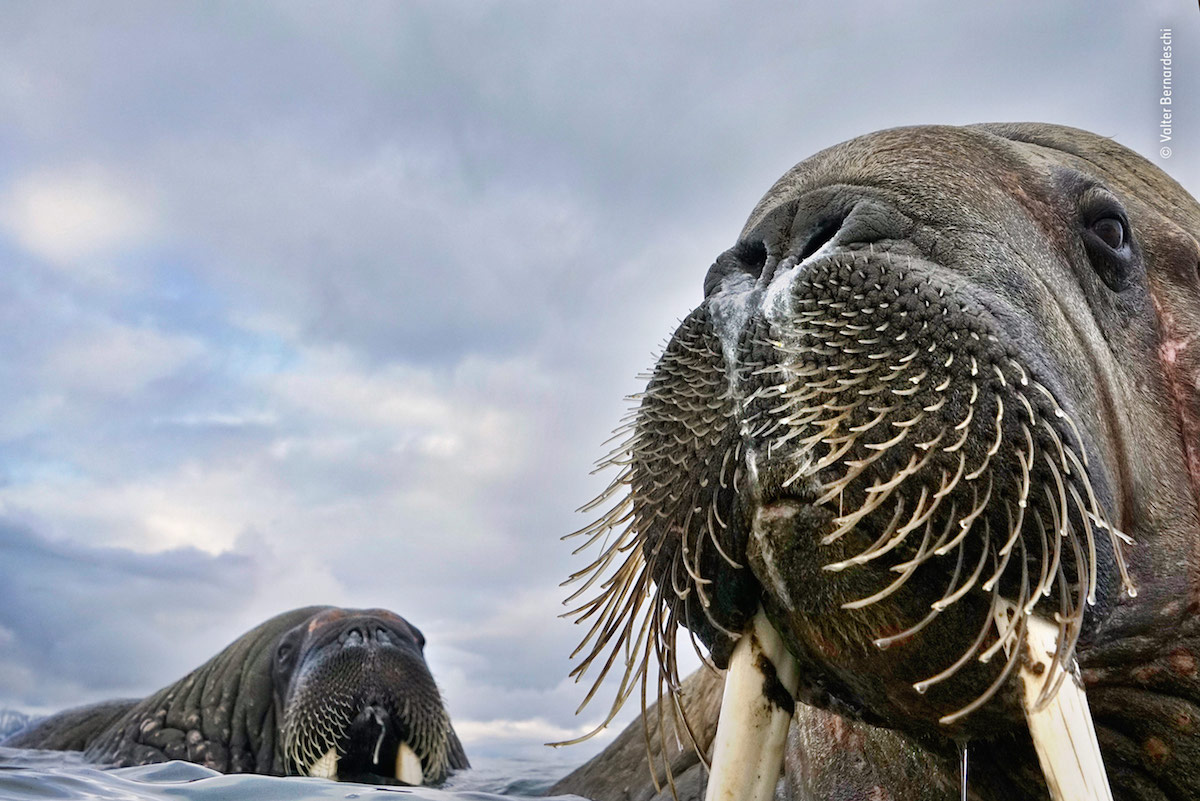
“Mister Whiskers” by Valter Bernardeschi, Italy / Wildlife Photographer of the Year.
It was a bright summer’s night when Valtercame across the walruses. They were feeding just off an island in the Norwegian archipelago off Svalbard. Putting on his wetsuit, and using a couple of monopod poles and a float to extend his camera in front of him, Valter slipped into the icy water. Immediately, a few curious walruses –mainly youngsters –began swimming towards him. Clumsy on land, these weighty giants now moved with ease and speed. Keeping at pole’s length, he was able to take this intimate portrait of the distinctive whiskered faces ofa youngster and its watchful mother. Walruses use their highly sensitive whiskers and snout to search out bivalve molluscs (such as clams) and other small invertebrates on the ocean floor.In the cold water, their thick protective skin appears grey when blood flow to its surface is reduced, but darker, reddish-brown when they are out of water and have warmed up. The tusks are not used for feeding but for display among the males, for defence against polar bears and for hauling themselves out, especially onto sea ice. They will rest on ice floes between bouts of feeding and even give birth on them.

“Looking for love” by Tony Wu, USA / Wildlife Photographer of the Year.
Accentuating his mature appearance with pastel colors, protruding lips and an outstanding pink forehead, this Asian sheepshead wrasse sets out to impress females and see off rivals, which he will head-butt and bite. Tony has long been fascinated by the species’ looks and life history. Individuals start out as females, and when they reach a certain age and size –up to a meter (more than 3 feet) long –can transform into males. Long-lived and slow-growing, the species is intrinsically vulnerable to overfishing. It favors rocky reefs in cool waters in the Western Pacific, where it feeds on shellfish and crustaceans, though little more is known about it. In a window of calm, amid high seas, Tony reached Japan’s remote Sado Island, to reveal some of the drama of the wrasses’ lives. Here, he conveys the suitor’s earnest intentions, written large on his face.
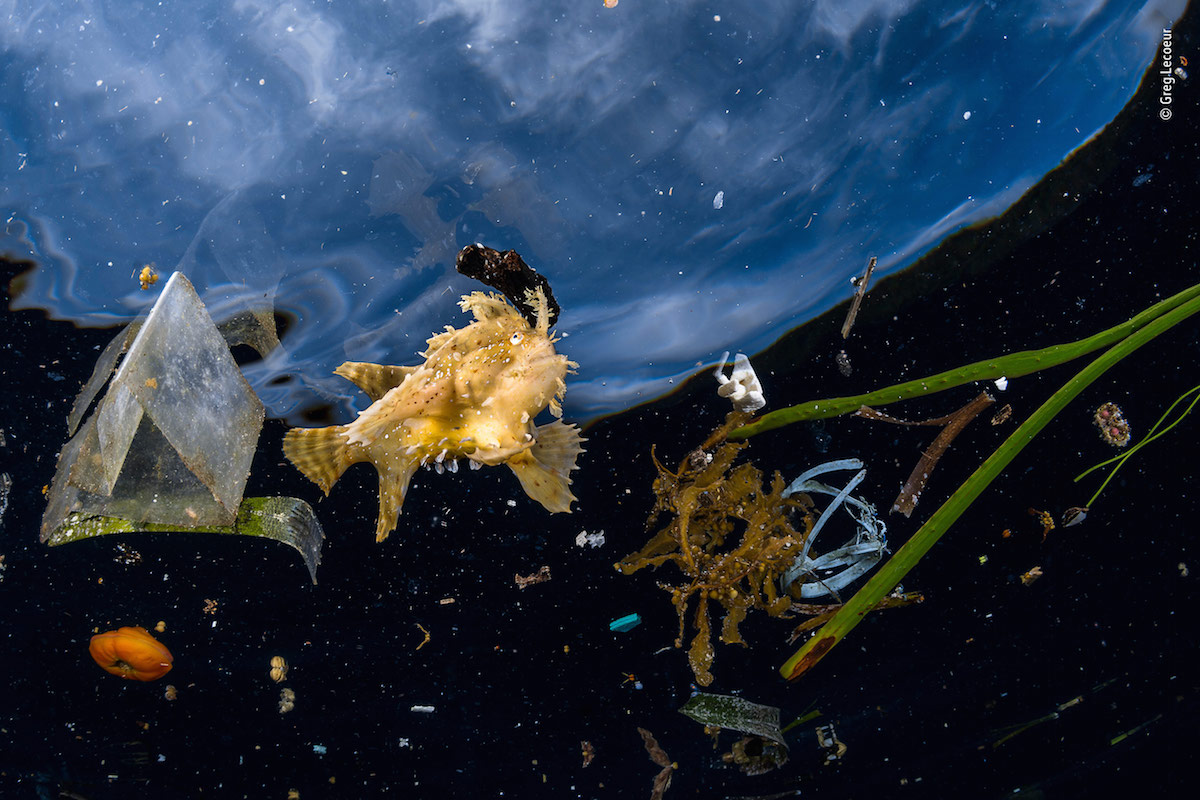
“Life among litter” by Greg Lecoeur, France / Wildlife Photographer of the Year.
This Sargassumfish couldn’t hide among the litter. The nearby frond of Sargassum seaweed was a far cry from the free-floating rafts of the seaweed that more normally shelter this frogfish and many other specialized species. Amaster of camouflage and an ambush predator, the Sargassumfish stalks its prey on claw-like fins through the fronds of these floating islands, concealed by its tan color and feathery outline. Greg spotted this individual when returning from a dive on the biodiverse reefs of the Indonesian archipelago of Raja Ampat. It is an area of the western Pacific Ocean where strong currents converge, bringing with them nutrients that sustain the rich biodiversity. The currents also collect and concentrate anything else that floats –including some of the millions of tonnes of plastic that end up in the oceans each year.
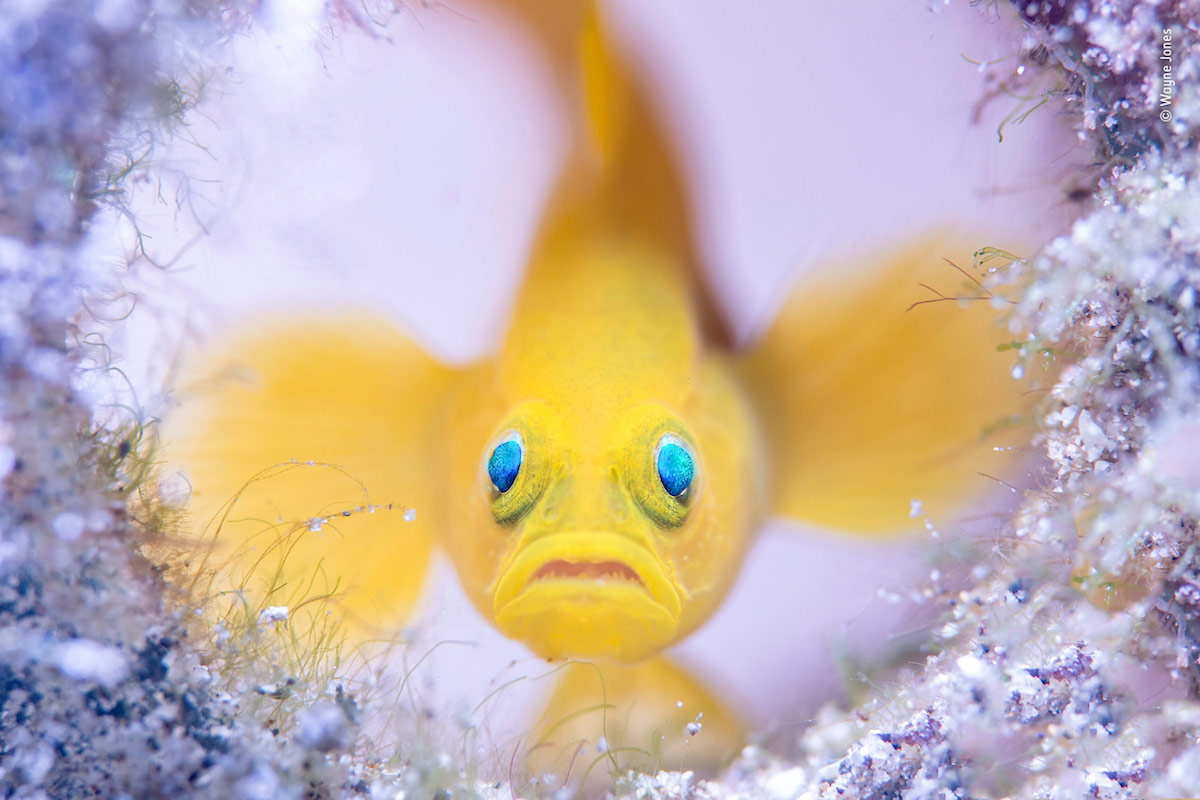
“Glass-house guard” by Wayne Jones, Australia / Wildlife Photographer of the Year.
On the sandy seabed off the coast of Mabiniin the Philippines, a yellow pygmy goby guards its home –a discarded glass bottle.It is one of a pair, each no more than 4 centimeters (1 and a half inches) long, that have chosen a bottle as a perfect temporary home.The female will lay several batches of eggs, while the male performs guard duty at the entrance. Setting up his camera a few centimeters in front of the bottle’s narrow opening,Wayne positioned his two strobes –one at the base of the bottle to illuminate the interior, and the other at the front to light the goby’s characteristic surprised face. Opting for a shallow depth of field,Wayne focused on the goby’s bulging blue eyes, allowing the movement of the fish to blur the rest of its features into a haze of yellow, and framing its portrait with the circular entrance to the bottle.
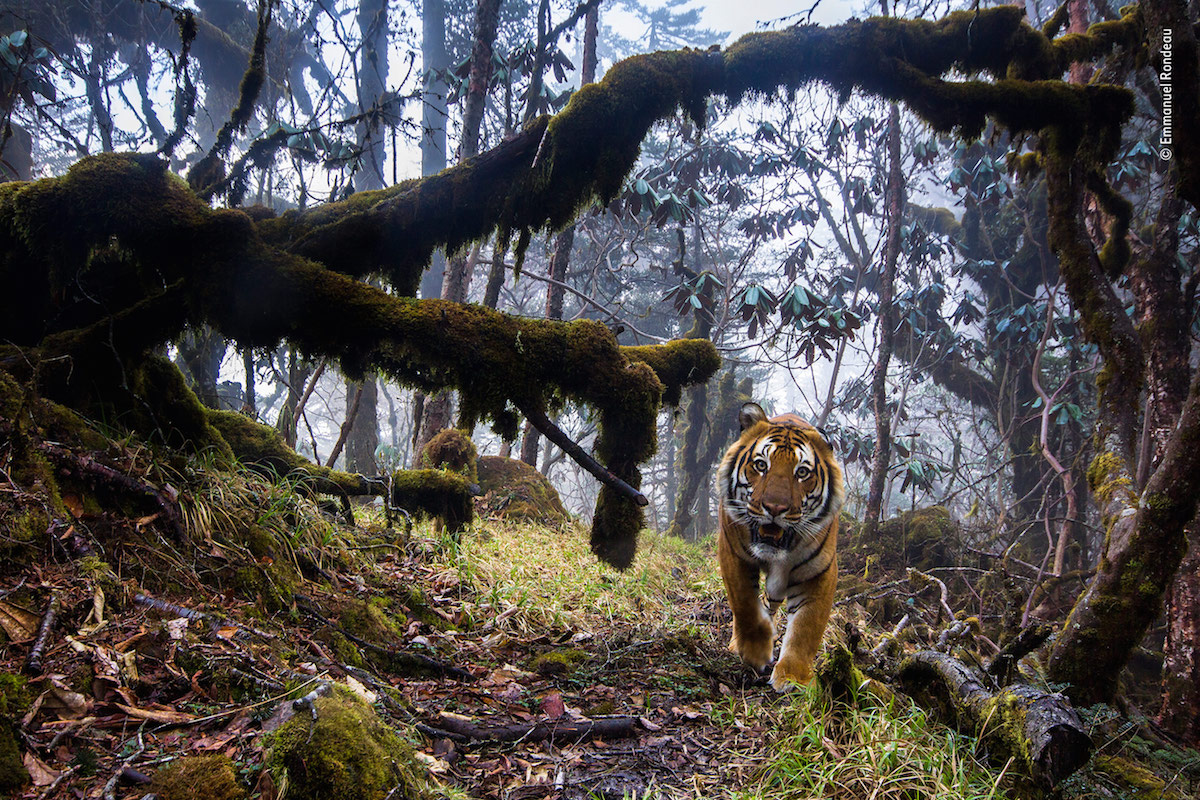
“Tigerland” by Emmanuel Rondeau, France / Wildlife Photographer of the Year.
In a remote forest, high in the Himalayas of central Bhutan, a Bengal tiger fixes his gaze on the camera. The path he treads is part of a network linking the country’s national parks –corridors that are key to the conservation of this endangered subspecies but unprotected from logging and poaching. Emmanueland a team of rangers climbed rugged terrain, with enough kit to setup eight still and eight video cameras along one route, in the hope of glimpsing a tiger pass by (there were just 103 in Bhutan at the last count). Concentrating on areas with previous tiger records, they searched for evidence of recent use –tracks, scratches and faeces –and then Emmanuel installed cameras on wooden posts in the most likely spots, composing the view so the subject would be framed within its mountain environment. After 23 days (and hundreds of false triggers by leaves and high winds), he hit the jackpot: amagnificent male tiger, and from his distinctive stripe pattern, one previously unrecorded in Bhutan. The tiger inspected the kit closely before disappearing into the forest, leaving this rare image, as if looking to us to protect his realm.
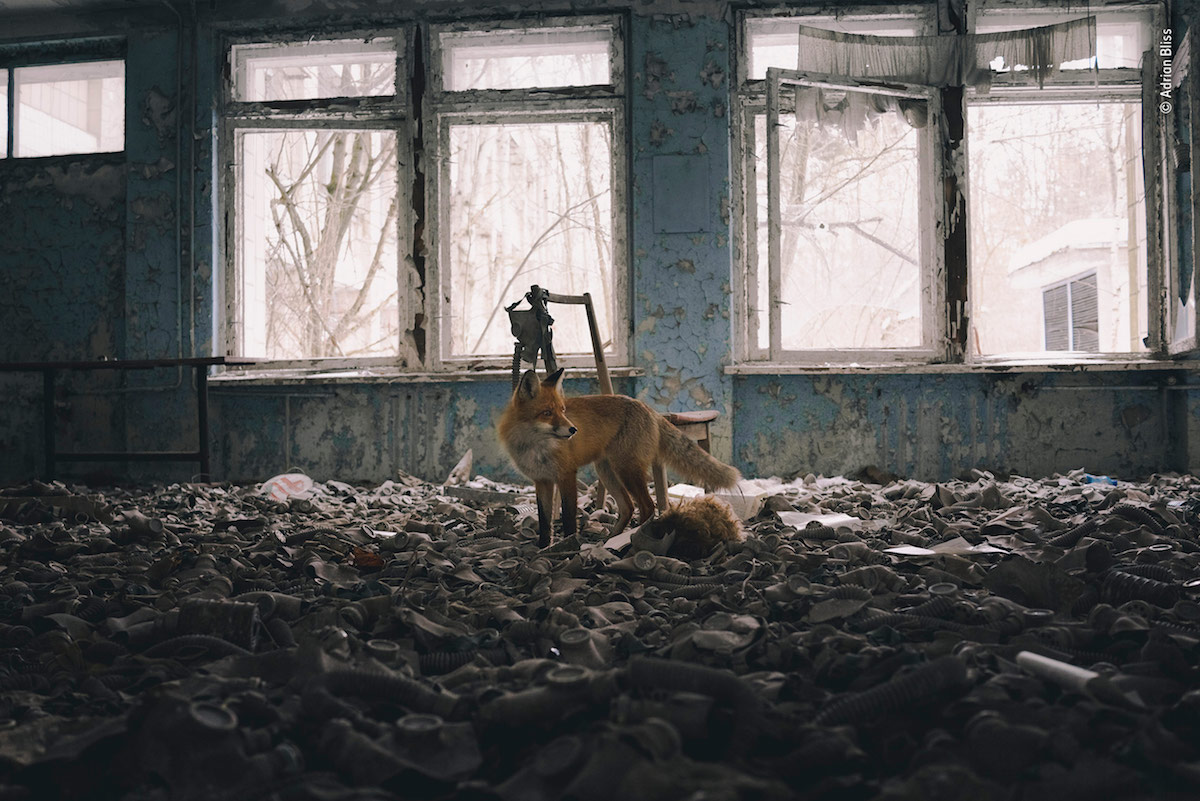
“School visit” by Adrian Bliss, UK / Wildlife Photographer of the Year.
Adrian was exploring the derelict schoolroom when the red fox trotted in, perhaps curious about the human or perhaps just on its rounds. It stopped briefly on the carpet of child-sized gas masks, just long enough for a picture, and then exited through a broken window. The school in Pripyat, Ukraine, was abandoned in 1986, as was the whole city, following the catastrophic explosion at the Chernobyl nuclear power plant, just 3 kilometers (nearly 2 miles) away. It was the worst nuclear accident in history, spreading radioactive fallout across Europe. Pripyat’s buildings are now decaying and have been looted (the gas masks –Cold War relics –were left as being of no value). The city lies within the 30-kilometer (19-mile) exclusion zone, which only accredited individuals can enter, and in the absence of humans, the forest is moving back in. Animals such as wild boar, deer, moose and lynx are making a comeback, and there are even sightings of brown bears and wolves. Though there were areas of the zone that Adrian was advised not to enter because radiation levels were still too high, and though the long-term effect of radiation on the animals is far from clear, wildlife appears to be thriving.
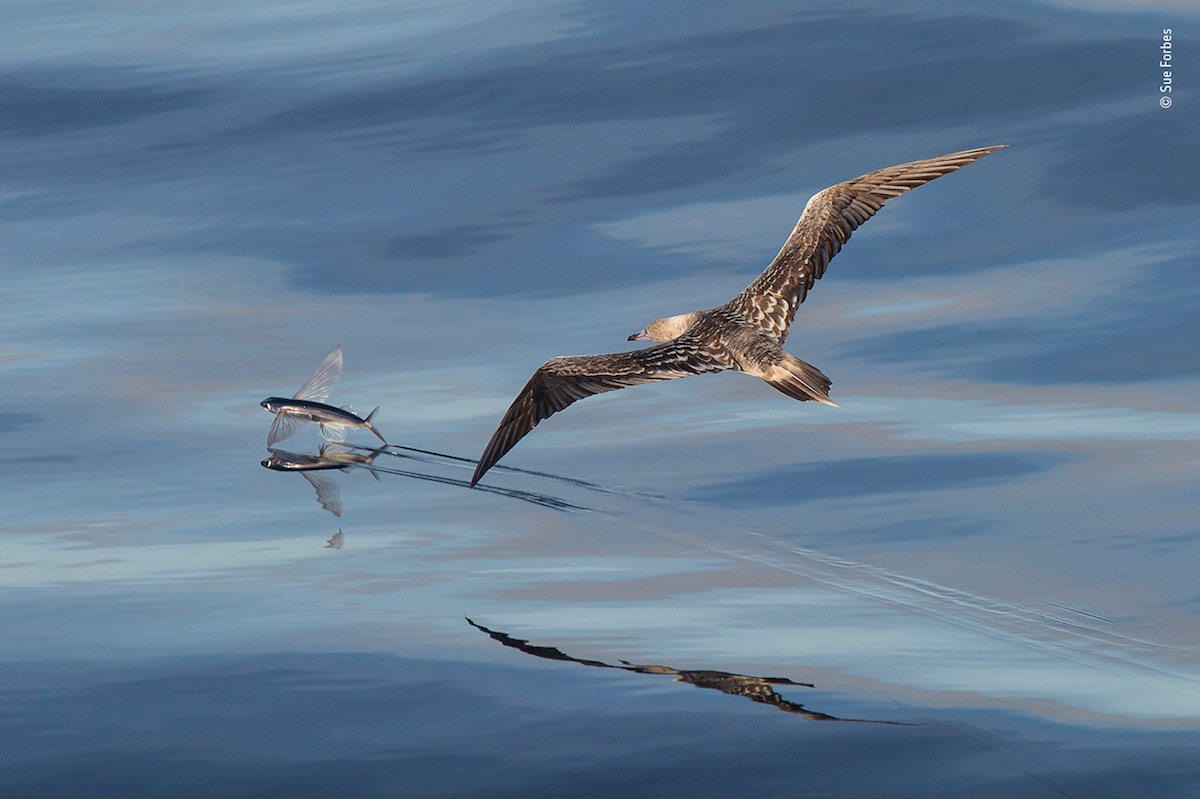
“Flight” by Sue Forbes, UK / Wildlife Photographer of the Year.
For days, Sue scanned rough seas in the Indian Ocean. ‘We’d often see flying fish,’ she says, ‘but only occasionally would there be boobies.’ Then, one morning –northeast of D’Arros Island in the Outer Islands of the Seychelles–she awoke to find tranquil water and a single juvenile red-footed booby, circling. These ocean-going birds–the smallest booby species, with a meter-wide (3-foot)wingspan–spend most of their time at sea, flying long distances with ease. Sharp-eyed, they swoop down to seize prey, mainly squid and flying fish. Their bodies are streamlined for plunge-diving –nostrils closed and wings pinned back–and nimble enough to grab flying fish in mid-air. Before breaking the surface to escape predators such as tuna and marlin, flyingfish build up tremendous speed under water, to glide, airborne, on their stiff pectoral fins. Sue kept her eye on the bird. Shehad no idea when and where a chase might happen. ‘Suddenly, a fish leapt out’, she says, ‘and down came the booby.’ With quick reactions, Sue captured the fleeting moment of the pursuit. The booby missed, and the fish got away.
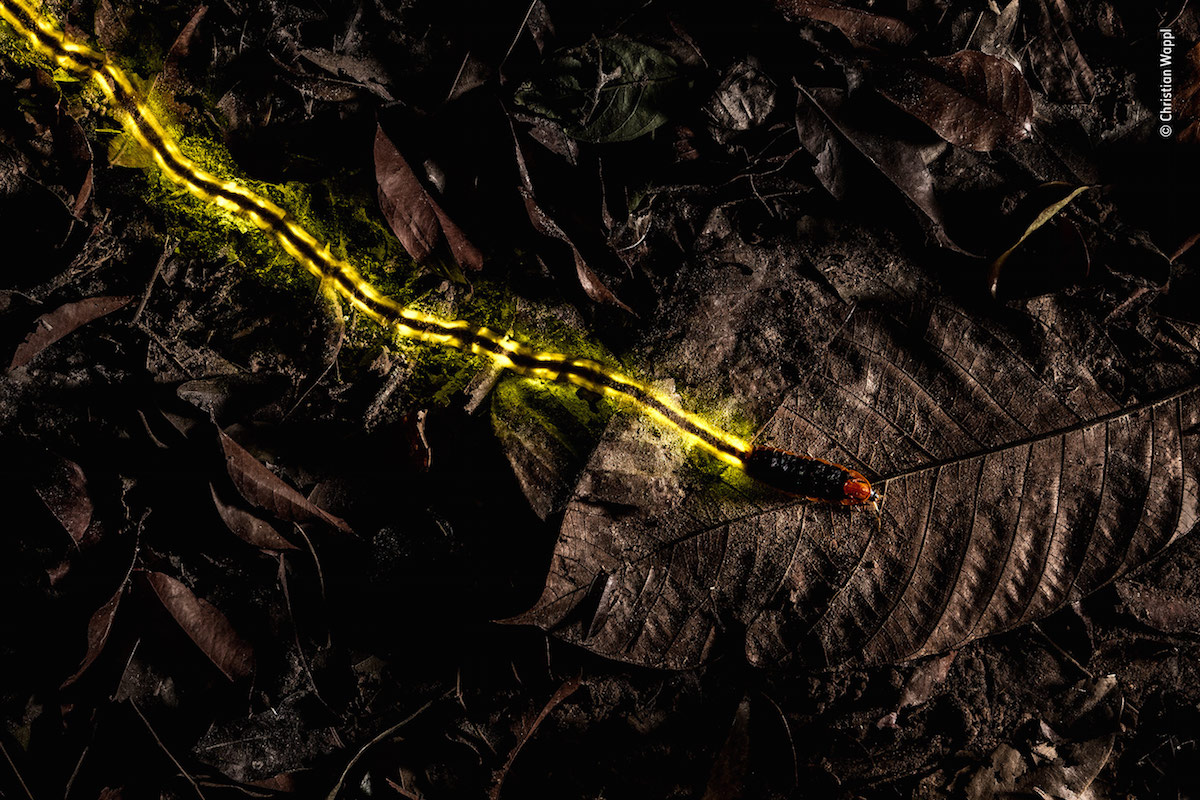
”Trailblazer” by Christian Wappl, Austria / Wildlife Photographer of the Year.
By 1am, the forest in Thailand’s Peninsular Botanic Garden was quiet, but in the leaf-litter, its nightlife still shone. The star of the show was a large firefly larva, about 8 centimeters (more than 3 inches) long, which emitted a continuous glow from four light organs at its rear. Fireflies spend most of their lives as larvae, feeding mainly on slugs and snails. This one can even tackle invasive African land snails many times its own size. Its glow –the result of a chemical reaction in its light organs –is most likely a warning to predators that it is unpalatable (whereas, the flashing lights of adult fireflies are for courtship). Framing his composition in almost complete darkness, guessing the direction the larva would take, Christian used a long (33-second) exposure, with a burst of flash at the end, to reveal the larva apparently blazing a trail through the night.
